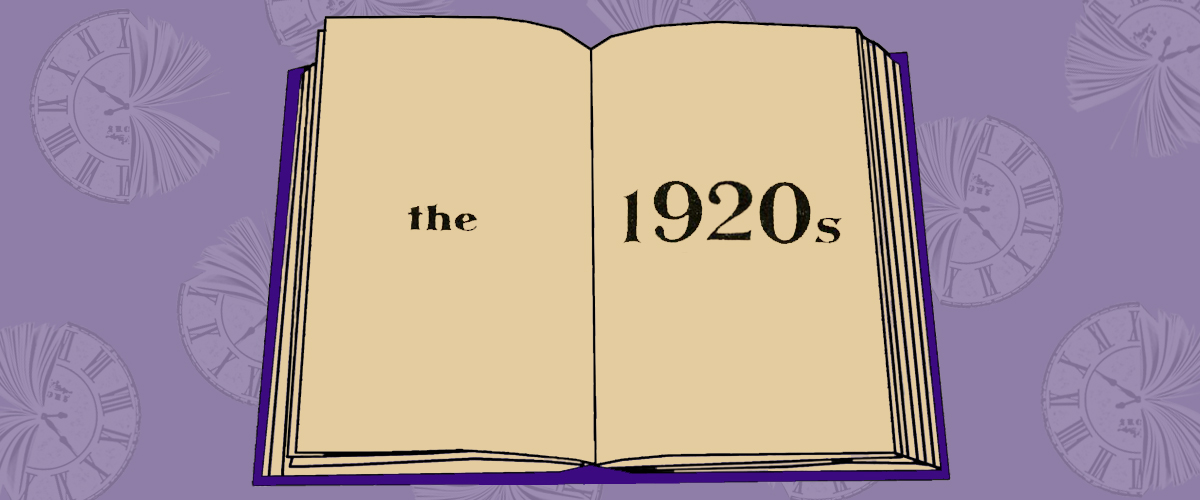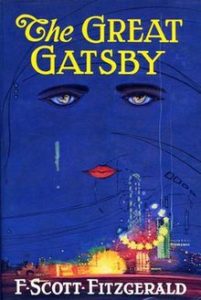↧
梅廣《上古漢語語法綱要》
↧
THE 10 BOOKS THAT DEFINED THE 1920S
A CENTURY OF READING: THE 10 BOOKS THAT DEFINED THE 1920S
PART THREE OF YOUR NEW FAVORITE SERIES
Some books are flashes in the pan, read for entertainment and then left on a bus seat for the next lucky person to pick up and enjoy, forgotten by most after their season has passed. Others stick around, are read and re-read, are taught and discussed. sometimes due to great artistry, sometimes due to luck, and sometimes because they manage to recognize and capture some element of the culture of the time.
In the moment, you often can’t tell which books are which. The Great Gatsby wasn’t a bestseller upon its release, but we now see it as emblematic of a certain American sensibility in the 1920s. Of course, hindsight can also distort the senses; the canon looms and obscures. Still, over the next weeks, we’ll be publishing a list a day, each one attempting to define a discrete decade, starting with the 1900s (as you’ve no doubt guessed by now) and counting down until we get to the (nearly complete) 2010s.
Though the books on these lists need not be American in origin, I am looking for books that evoke some aspect of American life, actual or intellectual, in each decade—a global lens would require a much longer list. And of course, varied and complex as it is, there’s no list that could truly define American life over ten or any number of years, so I do not make any claim on exhaustiveness. I’ve simply selected books that, if read together, would give a fair picture of the landscape of literary culture for that decade—both as it was and as it is remembered. Finally, two process notes: I’ve limited myself to one book for author over the entire 12-part list, so you may see certain works skipped over in favor of others, even if both are important (for instance, I ignored Dubliners yesterday so I could include Ulysses today), and in the case of translated work, I’ll be using the date of the English translation, for obvious reasons.
For our third installment, below you’ll find 10 books that defined the third decade of the 1900s—a decade that, as you may notice, the literary world is still particularly obsessed with.
ARTICLE CONTINUES AFTER ADVERTISEMENT
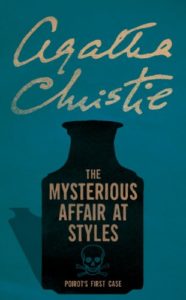 Agatha Christie, The Mysterious Affair at Styles (1920)
Agatha Christie, The Mysterious Affair at Styles (1920)Christie’s first published novel—and the first to feature her mega-famous creation Hercule Poirot—was released to wide acclaim (somewhat surprised acclaim, considering it was a first novel by an unknown) in 1920, helping to usher in the Golden Age of Detective Fiction, not to mention the enduring love affair that millions of fans would have with Christie’s work. According to the flap copy of the first edition, Christie wrote it after accepting a bet—that she couldn’t write a mystery novel in which the reader could spot the murderer before the detective. Everyone agrees that she won. Now she’s one of the best selling, widely translated, and most influential novelists of all time—but it all started here.
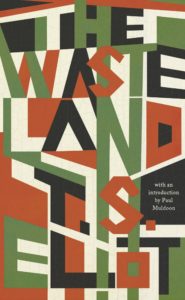 T. S. Eliot, The Waste Land (1922)
T. S. Eliot, The Waste Land (1922)Eliot’s masterpiece is widely considered to be one of the most important works of Modernist literature, not to mention 20th-century literature in general. The book-length poem, which Louis Menand describes as “a collage of allusion, quotation, echo, appropriation, pastiche, imitation, and ventriloquism,” but also “a report on the condition of postwar Europe,” didn’t sell particularly well (330 copies in the first six months), but the Cambridge academics seized upon it, and with Eliot’s other works, used it as the basis for creating the modern English department.
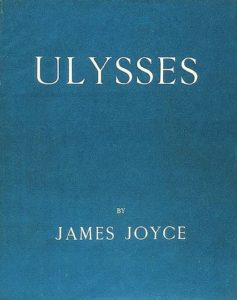 James Joyce, Ulysses (1922)
James Joyce, Ulysses (1922)ARTICLE CONTINUES AFTER ADVERTISEMENT
If we’re counting by literary influence, Ulysses was biggest book of the 20s by far—the most important Modernist text and certainly one of the most important novels ever written. “Ulysses,” T. S. Eliot told Virginia Woolf, “destroyed the whole of the 19th century. It left Joyce himself with nothing to write another book on. It showed up the futility of all the English styles.” For her part, Woolf wasn’t always convinced, but did sing its praises in her essay “Modern Fiction,” calling it “undeniably important . . . The scene in the cemetery, for instance, with its brilliancy, its sordidity, its incoherence, its sudden lightning flashes of significance, does undoubtedly come so close to the quick of the mind that, on a first reading at any rate, it is difficult not to acclaim a masterpiece. If we want life itself, here surely we have it.”
 Marcel Proust, Swann’s Way (1922)
Marcel Proust, Swann’s Way (1922)If any book could challenge Ulysses for the top spot in literary history, it’s Proust’s seven-volume masterpiece about memory, In Search of Lost Time, the first book of which was translated by C. K. Scott Moncrieff and published in English for the first time in 1922. In fact, in 2013 Edmund White called it “the most respected novel of the 20th century,” and noted that “in the last 30 years Proust has superseded Joyce.” Either way, like Ulysses, it is a widely influential, much-discussed, probably under-read, classic exemplar of the decade in literature, a text that reverberates through to much of our art today.
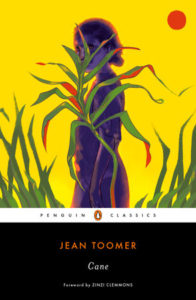 Jean Toomer, Cane (1923)
Jean Toomer, Cane (1923)Yet another Modernist masterpiece for this list, this one also a significant text of the Harlem Renaissance, notable for its experimental style, which blends poetry, prose, and drama to illuminate the lives of African Americans living under Jim Crow. Though it received positive—if sometimes baffled—reviews from contemporary critics, the book did not find widespread success in the decade of its publication. “The Negro artist works against an undertow of sharp criticism and misunderstanding from his own group and unintentional bribes from the whites,” wrote Langston Hughes in his 1926 essay “The Negro Artist and the Racial Mountain.”
“Oh, be respectable, write about nice people, show how good we are,” say the Negroes. “Be stereotyped, don’t go too far, don’t shatter our illusions about you, don’t amuse us too seriously. We will pay you,” say the whites. Both would have told Jean Toomer not to write Cane. The colored people did not praise it. The white people did not buy it. Most of the colored people who did read Cane hate it. They are afraid of it. Although the critics gave it good reviews the public remained indifferent. Yet (excepting the work of Du Bois) Cane contains the finest prose written by a Negro in America. And like the singing of Robeson, it is truly racial.
Now it’s considered one of the most important books of the Harlem Renaissance, and a Modernist classic, particularly notable for its formal flexibility and enduring influence on later works.
Given its enduring cultural relevance, it’s impossible to ignore this Great American Novel, and its influence on the way we imagine the 1920s in this country, despite the fact that in the actual 1920s, it wasn’t considered so great. Sure, readers loved This Side of Paradise and The Beautiful and the Damned, but The Great Gatsby represented something of a fall from grace. “Fitzgerald’s Latest A Dud” read the headline of a review in the New York World. Other reviewers were less critical but unenthusiastic, and by the time Fitzgerald died in 1940, the book had sold fewer than 25,000 copies. Now it sells 500,000 copies a year, if mostly to disgruntled students. It was WWII that rescued Gatsbyfrom obscurity. The US government developed a program to send cheap paperback books to soldiers, and of the 1,227 titles chosen, one of them was The Great Gatsby. The program was wildly popular—by some estimates more than a million soldiers read the novel—and Fitzgerald’s reputation soared. It hasn’t slowed down yet.
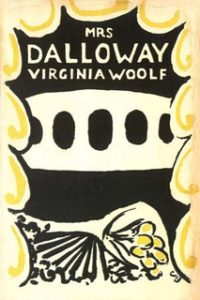 Virginia Woolf, Mrs. Dalloway (1925)
Virginia Woolf, Mrs. Dalloway (1925)You could argue (or at least I would) that To the Lighthouse (1927) is the more formally exciting—and even the better—book, that Orlando (1928) is decidedly more fun, and that A Room of One’s Own (1929) is the most widely and continually influential (or at least glibly quoted) but I think it’s safe to say that Mrs. Dalloway is the most loved. At least, that’s my read after surveying the Literary Hub office, the internet, and the members of my own personal family. It was also very well regarded in its time—in a contemporary review in the New York Times, John W. Crawford wrote:
Among Mrs. Woolf’s contemporaries, there are not a few who have brought to the traditional forms of fiction, and the stated modes of writing, idioms which cannot but enlarge the resources of speech and the uses of narrative. Virginia Woolf is almost alone, however, in the intricate yet clear art of her composition. . . . Clarissa is . . . conceived so brilliantly, dimensioned so thoroughly and documented so absolutely that her type, in the words of Constantin Stanislavsky, might be said to have been done ”inviolably and for all time.”
Despite all the competition, Mrs. Dalloway is a standout work in a standout career, a hallmark of the Modernist movement, and a splendid, wrenching, subtle psychological novel, beloved in its day and beloved now.
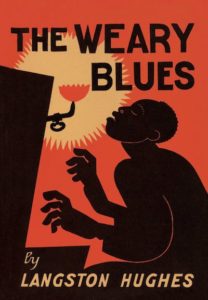 Langston Hughes, The Weary Blues (1926)
Langston Hughes, The Weary Blues (1926)The title poem of Langston Hughes’ first collection is still one of his most famous, weaving language and jazz together as in all the best of his work, and he’s probably the most important figure of the Harlem Renaissance. “It’s the poems that speak of being “Black like me”—black still being fighting words in some quarters—that prove especially moving,” wrote Kevin Young in an introduction to a 2014 edition of the book.
Hughes manages remarkably to take Whitman’s American “I” and write himself into it. After labeling the final section “Our Land,” the volume ends with one of the more memorable lines of the century, almost an anthem: “I, too, am America.”
Offering up a series of “Dream Variations,” as one section is called, Hughes, it becomes clear, is celebrating, critiquing, and completing the American dream, that desire for equality or at least opportunity. But his America takes in the Americas—including Mexico, where his estranged father moved to flee the color line of the United States—and even the West Coast of Africa, which he’d also visited. His well-paced poetry is laced with an impeccable exile.
A groundbreaking collection from an iconic American artist.
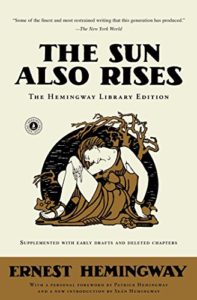 Ernest Hemingway, The Sun Also Rises (1926)
Ernest Hemingway, The Sun Also Rises (1926)Hemingway’s outsize influence and literary fame began with the publication of The Sun Also Rises, his first proper novel, and hasn’t abated much in the 90 years since. “No amount of analysis can convey the quality of The Sun Also Rises,” the New York Timespurred in the year of its release.
It is a truly gripping story, told in a lean, hard, athletic narrative prose that puts more literary English to shame. Mr. Hemingway knows how not only to make words be specific but how to arrange a collection of words which shall betray a great deal more than is to be found in the individual parts. It is magnificent writing, filled with that organic action which gives a compelling picture of character. This novel is unquestionably one of the events of an unusually rich year in literature.
In the years after, some writers would diligently copy his sparse, “athletic” prose, and others would fly descriptively in the opposite direction, but almost everyone would develop an opinion on him, and at least some degree of knowledge of him. He’s still, decades after his death, as beloved a literary celebrity as he was during his lifetime.
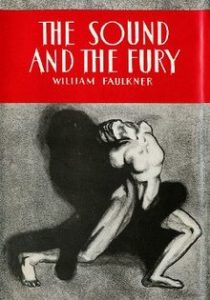 William Faulkner, The Sound and the Fury (1929)
William Faulkner, The Sound and the Fury (1929)We’ll round out this gutting (for me—I’ve had to cut so many!) list of literary giants with everyone’s least favorite postman, whose stream-of-consciousness masterpiece is one of the most difficult, important, complex, and lionized works of American literature—our best, not-so-humble contribution to the High Modernist era. Faulkner won the 1949 Nobel Prize for Literature for “his powerful and artistically unique contribution to the modern American novel.”
See also: D. H. Lawrence, Women in Love (1920), Edith Wharton, The Age of Innocence(1920), F. Scott Fitzgerald, This Side of Paradise (1920), Sinclair Lewis, Main Street(1920), Albert Einstein, The Meaning of Relativity (1922), Emily Post, Etiquette (1922), F. Scott Fitzgerald, The Beautiful and the Damned (1922), Katherine Mansfield, The Garden Party (1922), Margery Williams, The Velveteen Rabbit (1922), William Carlos Williams, Spring and All (1923), Carrie Chapman Catt and Nettie Rogers Shuler, Woman Suffrage and Politics: The Inner Story of the Suffrage Movement (1923), Robert Frost, New Hampshire (1923), Emma Goldman, My Disillusionment with Russia (1924), Thomas Mann, The Magic Mountain (1924), E. M. Forster, A Passage to India (1924), Herman Melville, Billy Budd, Sailor (1924), Theodore Dreiser, An American Tragedy (1925), Alain Locke, ed., The New Negro (1925), Anita Loos, Gentlemen Prefer Blondes (1925), A. A. Milne, Winnie-the-Pooh (1926), Thornton Wilder, Bridge of San Luis Rey (1927), Willa Cather, Death Comes for the Archbishop (1927), Virginia Woolf, To the Lighthouse (1927), Virginia Woolf, Orlando (1928), Aldous Huxley, Point Counter Point (1928), Evelyn Waugh, Decline and Fall (1928), Dashiell Hammett, Red Harvest (1929), Virginia Woolf, A Room of One’s Own (1929), Thomas Wolfe, Look Homeward, Angel (1929), Henry Green, Living (1929), Ernest Hemingway, A Farewell to Arms (1929), Erich Maria Remarque, All Quiet on the Western Front (1929), Nella Larsen, Passing (1929), etc.
↧
↧
Walt Whitman’s 200th birthday,... Leaves of Grass
Walt Whitman 全集,早已有中文本。長詩《草葉集》Leaves of Grass,也有幾個中文譯本。
“Re-examine all you have been told in school or church or in any book, and dismiss whatever insults your own soul…”
--Walt Whitman, Leaves of Grass preface (1855)
"I see great things in baseball. It's our game — the American game."
題詞是惠特曼:"Behold I do not give lectures or a little charity,
When I give I give myself." - Walt Whitman
1992年的美國總統選舉日,我與阿擘回他的母校加州大學UC Davis ,住在附近的民宿。由於是假日,靜得"不可思議",天地悠悠,我在附近的草地走走.....
當年我在杜邦公司"服務",當時已知公司要將我們整個事業部門"賣出" (也許4億美元),有點傷心:因為我將台灣的工廠和市場單位"轉型",不過,那只是戰爭中的一場地方戰役......所以決定休年假。.....
A reminder: Walt Whitman really, really liked Election Day. Nothing could quicken the man’s pulse like a good showing at the polls.
一併請教您老人家,我今日讀 Whitman 的O Capaitain! My Captain! ,首段提到大船入港,用一句 the vessel "grim and daring" 。一般翻譯是威嚴勇敢,可是我查字典,grim 是 without hope 或unpleasant , daring 是正確的。不高興或沒希望,形容這艘船似乎不是很搭,
布 "
"O Captain! My Captain!"
by: Walt Whitman
by: Walt Whitman
O Captain! my Captain! our fearful trip is done,
The ship has weather'd every rack, the prize we sought is won,
The port is near, the bells I hear, the people all exulting,
While follow eyes the steady keel, the vessel grim and daring;
But O heart! heart! heart!
O the bleeding drops of red,
Where on the deck my Captain lies,
Fallen cold and dead.
The ship has weather'd every rack, the prize we sought is won,
The port is near, the bells I hear, the people all exulting,
While follow eyes the steady keel, the vessel grim and daring;
But O heart! heart! heart!
O the bleeding drops of red,
Where on the deck my Captain lies,
Fallen cold and dead.
O Captain! my Captain! rise up and hear the bells;
Rise up--for you the flag is flung--for you the bugle trills,
For you bouquets and ribbon'd wreaths--for you the shores a-crowding,
For you they call, the swaying mass, their eager faces turning;
Here Captain! dear father!
This arm beneath your head!
It is some dream that on the deck,
You've fallen cold and dead.
Rise up--for you the flag is flung--for you the bugle trills,
For you bouquets and ribbon'd wreaths--for you the shores a-crowding,
For you they call, the swaying mass, their eager faces turning;
Here Captain! dear father!
This arm beneath your head!
It is some dream that on the deck,
You've fallen cold and dead.
My Captain does not answer, his lips are pale and still,
My father does not feel my arm, he has no pulse nor will,
The ship is anchor'd safe and sound, its voyage closed and done,
From fearful trip the victor ship comes in with object won;
Exult O shores, and ring O bells!
But I with mournful tread,
Walk the deck my Captain lies,
Fallen cold and dead.
My father does not feel my arm, he has no pulse nor will,
The ship is anchor'd safe and sound, its voyage closed and done,
From fearful trip the victor ship comes in with object won;
Exult O shores, and ring O bells!
But I with mournful tread,
Walk the deck my Captain lies,
Fallen cold and dead.
---
Walt Whitman
"Two Rivulets" by Walt Whitman
Two Rivulets side by side,
Two blended, parallel, strolling tides,
Companions, travelers, gossiping as they journey.
For the Eternal Ocean bound,
These ripples, passing surges, streams of Death and Life,
Object and Subject hurrying, whirling by,
The Real and Ideal,
Alternate ebb and flow the Days and Nights,
(Strands of a Trio twining, Present, Future, Past.)
In You, whoe'er you are, my book perusing, 10
In I myself--in all the World--these ripples flow,
All, all, toward the mystic Ocean tending.
(O yearnful waves! the kisses of your lips!
Your breast so broad, with open arms, O firm, expanded shore!)
Poet Walt Whitman was born 199 years ago in West Hills, New York #OTD in 1819.
Vintage Books & Anchor Books
Poet Walt Whitman was born in West Hills, New York on this day in 1819.
“Exclusive emphasis on either the physical or the spiritual Whitman misses his determined intermingling of the two realms. His earliest notebook poem contained the lines, “I am the poet of the body / And I am the poet of the soul,” establishing at once the interpenetration and cross-fertilization between matter and spirit that is felt in virtually all his major poems. The earthly and the divine, the sensuous and the mystical, are never far from each other in his verse. His images flow rapidly from the minutiae of plant or animal life through parts of the human body to sweeping vistas of different times and places,”
―from WALT WHITMAN'S AMERICA: A Cultural Biography (1995) by David S. Reynolds, Winner of the Bancroft Prize and the Ambassador Book Award
―from WALT WHITMAN'S AMERICA: A Cultural Biography (1995) by David S. Reynolds, Winner of the Bancroft Prize and the Ambassador Book Award
In his poetry Walt Whitman set out to encompass all of America and in so doing heal its deepening divisions. This magisterial biography demonstrates the epic scale of his achievement, as well as the dreams and anxieties that impelled it, for it places the poet securely within the political and cultural context of his age. Combing through the full range of Whitman’s writing, David Reynolds shows how Whitman gathered inspiration from every stratum of nineteenth-century American life: the convulsions of slavery and depression; the raffish dandyism of the Bowery “b’hoys”; the exuberant rhetoric of actors, orators, and divines. We see how Whitman reconciled his own sexuality with contemporary social mores and how his energetic courtship of the public presaged the vogues of advertising and celebrity. Brilliantly researched, captivatingly told, Walt Whitman’s America is a triumphant work of scholarship that breathes new life into the biographical genre. READ more here: https://www.penguinrandomhouse.com/…/walt-whitmans-america…/
Happy birthday Walt Whitman! Born today in New York in 1819. Here's D. Graham Burnett on the curious power of Whitman’s posthumous eyelids: https://buff.ly/2J4LlmM
↧
E.B. White (1899~1985)
“I would say that writing, in its own way, is a rival to therapy.”
From "The Little Prince and Other Sociopaths I've Dated" to "Charlotte's Web of Lies"––all your favorite childhood stories, now reimagined with the crippling anxieties of adulthood.
(Redirected from E.B. White)
| E. B. White | |
|---|---|
 White on the beach with his dog Minnie | |
| Born | Elwyn Brooks White July 11, 1899 Mount Vernon, New York, U.S. |
| Died | October 1, 1985 (aged 86) North Brooklin, Maine, U.S. |
| Education | Cornell University |
| Occupation | Writer |
| Spouse(s) | Katharine Sergeant (m. 1929; d. 1977) |
| Signature | |
 | |
Elwyn Brooks White (July 11, 1899 – October 1, 1985)[1] was an American writer and a world federalist.[2] For more than fifty years, he was a contributor to The New Yorker magazine. He was also a co-author of the English language style guide The Elements of Style, which is commonly known as Strunk & White. In addition, he wrote books for children, including Stuart Little (c. 1945), Charlotte's Web (c. 1952), and The Trumpet of the Swan (c. 1970). In a 2012 survey of School Library Journal readers, Charlotte's Web was voted the top children's novel.[3]
Contents
[hide]Life
A selection of the best of the hilarious free-verse poems by the irreverent cockroach poet Archy and his alley-cat pal Mehitabel. Don Marquis’s famous fictional insect appeared in his newspaper columns from 1916 into the 1930s, and he has delighted generations of readers ever since. A poet in a former life, Archy was reincarnated as a bug who expresses himself by diving headfirst onto a typewriter. His sidekick Mehitabel is a streetwise feline who claims to have been Cleopatra in a previous life. As E. B. White wrote in his now-classic introduction, the Archy poems “contain cosmic reverberations along with high comedy” and have “the jewel-like perfection of poetry.” Adorned with George Herriman’s whimsical illustrations and including White’s introduction, our Pocket Poets selection—the only hardcover Archy and Mehitabel in print—is a beautiful volume, and perfectly sized for its tiny hero.
READ an excerpt from the introduction by E.B. White here: https://www.penguinrandomhouse.com/…/the-best-of-archy-and…/
↧
Edgar Allen Poe : Selected Prose, Poetry, and Eureka/ Annabel Lee (1849)
“I have absolutely no pleasure in the stimulants in which I sometimes so madly indulge. It has not been in the pursuit of pleasure that I have periled life and reputation and reason. It has been the desperate attempt to escape from torturing memories, from a sense of insupportable loneliness and a dread of some strange impending doom.”
― Edgar Allan Poe
― Edgar Allan Poe
One of the most original American writers, Edgar Allen Poe shaped the development of both the detective story and the science-fiction story. Some of his poems—”The Raven,” “The Bells,” “Annabel Lee”—remain among the most popular in American literature. Poe’s tales of the macabre still thrill readers of all ages. Here are familiar favorites like “The Purloined Letter,” “The Fall of the House of Usher,” and “The Murders in the Rue Morgue,” together with less-known masterpieces like “The Imp of the Perverse,” “The Narrative of A. Gordon Pym,” and “Ligeia,” which is now recognized as one of the first science-fiction stories, a total of seventy-three tales in all, plus fifty-three poems and a generous sampling of Poe’s essays, criticism and journalistic writings.
The New York Review of Books
Marilynne Robinson on Edgar Allan Poe
On Edgar Allan Poe by Marilynne Robinson
Edgar Allan Poe was and is a turbulence, an anomaly among the major American writers of his period, an anomaly to this day. He both amazed and antagonized his contemporaries, who could not dismiss him from the first...
NYBOOKS.COM
British Museum新增了 2 new photos。
Edgar Allan Poe was born #onthisday in 1809. These are illustrations to his poems: ‘The Raven’ by Édouard Manet and ‘The Sleeper’ by Dante Gabriel Rossetti
Annabel Lee
By Edgar Allan Poe
Annabel Lee (1849)
Wikisource has original text related to this article:
Annabel Lee
Main article: Annabel Lee
The last complete poem written by Poe, it was published shortly after his death in 1849. The speaker of the poem talks about a lost love, Annabel Lee, and may have been based on Poe's own relationship with his wife Virginia, though that is disputed.
Edgar Allan Poe died in Baltimore, Maryland, on this day in 1849 (aged 40).
"Annabel Lee"
It was many and many a year ago,
In a kingdom by the sea,
That a maiden there lived whom you may know
By the name of Annabel Lee;
And this maiden she lived with no other thought
Than to love and be loved by me.
In a kingdom by the sea,
That a maiden there lived whom you may know
By the name of Annabel Lee;
And this maiden she lived with no other thought
Than to love and be loved by me.
I was a child and she was a child,
In this kingdom by the sea,
But we loved with a love that was more than love—
I and my Annabel Lee—
With a love that the wingèd seraphs of Heaven
Coveted her and me.
In this kingdom by the sea,
But we loved with a love that was more than love—
I and my Annabel Lee—
With a love that the wingèd seraphs of Heaven
Coveted her and me.
And this was the reason that, long ago,
In this kingdom by the sea,
A wind blew out of a cloud, chilling
My beautiful Annabel Lee;
So that her highborn kinsmen came
And bore her away from me,
To shut her up in a sepulchre
In this kingdom by the sea.
In this kingdom by the sea,
A wind blew out of a cloud, chilling
My beautiful Annabel Lee;
So that her highborn kinsmen came
And bore her away from me,
To shut her up in a sepulchre
In this kingdom by the sea.
The angels, not half so happy in Heaven,
Went envying her and me—
Yes!—that was the reason (as all men know,
In this kingdom by the sea)
That the wind came out of the cloud by night,
Chilling and killing my Annabel Lee.
Went envying her and me—
Yes!—that was the reason (as all men know,
In this kingdom by the sea)
That the wind came out of the cloud by night,
Chilling and killing my Annabel Lee.
But our love it was stronger by far than the love
Of those who were older than we—
Of many far wiser than we—
And neither the angels in Heaven above
Nor the demons down under the sea
Can ever dissever my soul from the soul
Of the beautiful Annabel Lee;
Of those who were older than we—
Of many far wiser than we—
And neither the angels in Heaven above
Nor the demons down under the sea
Can ever dissever my soul from the soul
Of the beautiful Annabel Lee;
For the moon never beams, without bringing me dreams
Of the beautiful Annabel Lee;
And the stars never rise, but I feel the bright eyes
Of the beautiful Annabel Lee;
And so, all the night-tide, I lie down by the side
Of my darling—my darling—my life and my bride,
In her sepulchre there by the sea—
In her tomb by the sounding sea.
Of the beautiful Annabel Lee;
And the stars never rise, but I feel the bright eyes
Of the beautiful Annabel Lee;
And so, all the night-tide, I lie down by the side
Of my darling—my darling—my life and my bride,
In her sepulchre there by the sea—
In her tomb by the sounding sea.
*
A compact selection of Poe’s greatest stories and poems, chosen by the National Endowment for the Arts for their Big Read program. This selection of eleven stories and seven poems contains such famously chilling masterpieces of the storyteller’s art as “The Tell-tale Heart,” “The Fall of the House of Usher,” “The Cask of Amontillado,” and “The Pit and the Pendulum,” and such unforgettable poems as “The Raven,” “The Bells,” and “Annabel Lee.” Poe is widely credited with pioneering the detective story, represented here by “The Purloined Letter,” “The Mystery of Marie Roget,” and “The Murders in the Rue Morgue.” Also included is his essay “The Philosophy of Composition,” in which he lays out his theory of how good writers write, describing how he constructed “The Raven” as an example.
優美的安娜貝爾.李 寒徹顫慄早逝去
作者:大江健三郎
譯者:許金龍
出版社:北京:人民文學: 2009 聯經出版公司 :2009年
書名脫胎自美國詩人艾倫坡著名詩作〈安娜貝爾.李〉,講述二戰後為美國人所收養的日本國際級女演員櫻闖蕩國際影壇多年後,回國參與記念德國作家亨利希. 封.克萊斯特跨國性電影拍攝計畫。主催此計畫的電影製片人木守,找來從大學時代就認識的社會運動伙伴小說家大江擔綱電影的劇本家,他嘗試將原作的抗暴情節 與日本農民的反壓迫的起義事件連結,而以女演員櫻為中心的拍攝,女英雄的形象也取代原著以男性為故事主角的設定;小說家大江的母親,在戰後不惜冒黑市交易 風險、也要維持地方劇團演出的「說故事者」使命,則分在演員櫻、小說家大江以及承襲母親故事採集者、長期在四國推行女權運動的小說家的妹妹身上顯現;但這 個拍攝計畫卻因一個涉及櫻的殘忍祕密而宣告終止。
------
Roland Barthes《巴爾特自述‧片斷‧真理與穩定性》北京:中國人民大學,2008,頁73
坡說過 (Eureka) :「真理存在於穩定性之中。」因此,不能承受穩定性的人﹑,便把真理之倫理學置之身外。一旦語詞、命題、觀念採取和過渡到固定狀態、俗套狀態 (俗套意味著固定),他就把它們放棄。
坡說過 (Eureka) :「真理存在於穩定性之中。」因此,不能承受穩定性的人﹑,便把真理之倫理學置之身外。一旦語詞、命題、觀念採取和過渡到固定狀態、俗套狀態 (俗套意味著固定),他就把它們放棄。
Poe原文是英文,中譯本從法文轉譯,所以穩定性可能指consistency…..
It is, perhaps, in no little degree, however, our propensity for the continuous -- for the analogical -- in the present case more particularly for the symmetrical which has been leading us astray. And, in fact, the sense of the symmetrical is an instinct which may be depended upon with an almost blindfold reliance. It is the poetical essence of the Universe -- OF0,0 which, in the supremeness of its symmetry, is but the most sublime of poems. Now symmetry and consistency are convertible terms: -- thus Poetry and Truth are one. A thing is consistent in the ratio of its truth -- true in the ratio of its consistency. A Perfect consistency, I repeat, can be nothing but a absolute truth. We may take it for granted, then, that Man cannot long or widely err, if he suffer himself to be guided by his poetical, which I have maintained to be his truthful, in being his symmetrical, instinct. He must have a care, however, lest, in pursuing too heedlessly the superficial symmetry of forms and motions, he leave out of sight the really essential symmetry of the principles which determine and control them.
Poe 的這篇散文詩的前言令人震撼…….
Eureka - A Prose Poem
By: Edgar Allan Poe
(1848)
WITH VERY PROFOUND RESPECT,
THIS WORK IS DEDICATED
TO
ALEXANDER VON HUMBOLDT
PREFACE
To the few who love me and whom I love -- to those who feel rather than to those who think -- to the dreamers and those who put faith in dreams as in the only realities -- I offer this Book of Truths, not in its character of Truth-Teller, but for the Beauty that abounds in its Truth; constituting it true. To these I present the composition as an Art-Product alone:- let us say as a Romance; or, if I be not urging too lofty a claim, as a Poem.
What I here propound is true:- * therefore it cannot die:- or if by any means it be now trodden down so that it die, it will "rise again to the Life Everlasting."
Nevertheless it is as a Poem only that I wish this work to be judged after I am dead.
E. A. P.
Eureka - A Prose Poem
By: Edgar Allan Poe
(1848)
WITH VERY PROFOUND RESPECT,
THIS WORK IS DEDICATED
TO
ALEXANDER VON HUMBOLDT
PREFACE
To the few who love me and whom I love -- to those who feel rather than to those who think -- to the dreamers and those who put faith in dreams as in the only realities -- I offer this Book of Truths, not in its character of Truth-Teller, but for the Beauty that abounds in its Truth; constituting it true. To these I present the composition as an Art-Product alone:- let us say as a Romance; or, if I be not urging too lofty a claim, as a Poem.
What I here propound is true:- * therefore it cannot die:- or if by any means it be now trodden down so that it die, it will "rise again to the Life Everlasting."
Nevertheless it is as a Poem only that I wish this work to be judged after I am dead.
E. A. P.
*****
Edgar Allen Poe : Selected Prose, Poetry, and Eureka
這本書 書林翻印過
Auden 的 Introduction
Poor Poe! At first so forgotten that his grave went without a tomb-stone twenty-six years ... today in danger of becoming the life study of a few professors.
(W.H. (Wystan Hugh) Auden (1907-1973), Anglo-American poet. repr. In The Recognition of Edgar Allen Poe, ed. E.W. Carlson (1970). Edgar Allan Poe, introduction (1950).)
Edgar Allan Poe - Tales Of Mystery And Imagination (Illustrator - Harry Clarke)
“EDGAR ALLAN POE died in Baltimore on Sunday last.”
↧
↧
Les Fleurs du mal (Flowers of Evil 惡之華) 法應網
Carlos Schwabe, Jul 1866-Jan 1926 : Remords (Les Fleurs du Mal)Remorse (The Flowers of Evil)
http://fleursdumal.org/
FleursDuMal.org
Fleursdumal.org is dedicated to the French poet Charles Baudelaire (1821 - 1867), and in particular to Les Fleurs du mal (Flowers of Evil). The definitive online edition of this masterwork of French literature, Fleursdumal.org contains every poem of each edition of Les Fleurs du mal, together with multiple English translations — most of which are exclusive to this site and are now available in digital form for the first time ever.
QuickStart. If you're new to Baudelaire, or if you're not interested in the nuances of the various editions of the Flowers of Evil, you should browse poems using the 1861 Table of Contents. This is the definitive edition of Les Fleurs du mal and contains most everything the casual browser would want to read, except perhaps the "condemned poems" which you can find in Les Épaves (scraps).
The advanced reader of Baudelaire will want to take advantage of the different ways to view the poems that make up Les Fleurs du mal.
This was the first edition of Les Fleurs du mal and contained a hundred poems written in the 1840s and 1850s. (Note that this table of contents reflects the original order of the 1857 edition. However, the French poems to which it links are the later "definitive" versions of the poems published in 1861.)
This second edition contained thirty-five additional poems and the new "Tableaux parisiens" section. However, it lacked the six poems censored from the first edition.
While living in Brussels, Baudelaire and his publisher decided to put out this collection of "scraps" containing a miscellany of poems. Most important, it included the six poems censored from the first edition of Les Fleurs du mal, which were illegal to publish in France until the 1940s.
This edition of Les Fleurs du mal was prepared after Baudelaire's death by two of his friends. Modern scholars reject this version because they question some of the changes the friends made. Preference is therefore given to the last version overseen by Baudelaire himself, which was the 1861 edition.
All of the tables of contents give the titles in French, with literal English translations of the titles in smaller type. Please note that Supervert has made every effort to be accurate in handling Baudelaire's poetry. If you happen to notice any errors, no matter how small, please let us know.
http://fleursdumal.org/1861-table-of-contents
↧
Poker Face: The Rise and Rise of Lady Gaga女神卡卡的降臨
Poker Face: The Rise and Rise of Lady Gaga Hardcover – September 14, 2010
by Maureen Callahan
女神卡卡的降臨,台北:時周文化,2010![]()
Lady Gaga - Poker Face - YouTube
https://www.youtube.com/watch?v=bESGLojNYSo
Lyrics

Lady Gaga - Poker Face - YouTube
https://www.youtube.com/watch?v=bESGLojNYSo
Lyrics
I wanna hold 'em like they do in Texas plays
Fold 'em, let 'em, hit me, raise it baby stay with me (I love it)
Love Game intuition play the cards with spades to start
And after he's been hooked I'll play the one that's on his heart
Fold 'em, let 'em, hit me, raise it baby stay with me (I love it)
Love Game intuition play the cards with spades to start
And after he's been hooked I'll play the one that's on his heart
Oh, oh, oh, oh, oh, oh-oh-e-oh-oh-oh
I'll get him hot, show him what I've got
Oh, oh, oh, oh, oh, oh-oh-e-oh-oh-oh,
I'll get him hot, show him what I've got
I'll get him hot, show him what I've got
Oh, oh, oh, oh, oh, oh-oh-e-oh-oh-oh,
I'll get him hot, show him what I've got
Can't read my
Can't read my
No he can't read my poker face
(She's got me like nobody)
Can't read my
Can't read my
No he can't read my poker face
(She is gonna let nobody)
Can't read my
No he can't read my poker face
(She's got me like nobody)
Can't read my
Can't read my
No he can't read my poker face
(She is gonna let nobody)
P p p poker face, p p p poker face
(Muh muh muh muh)
P p p poker face, p p poker face
(Muh muh muh muh)
(Muh muh muh muh)
P p p poker face, p p poker face
(Muh muh muh muh)
I wanna roll with him a hard pair we will be
A little gambling is fun when you're with me (I love it)
Russian Roulette is not the same without a gun
And baby when it's love, if its not rough it isn't fun, fun
A little gambling is fun when you're with me (I love it)
Russian Roulette is not the same without a gun
And baby when it's love, if its not rough it isn't fun, fun
Oh, oh, oh, oh, oh, oh-oh-e-oh-oh-oh
I'll get him hot, show him what I've got
Oh, oh, oh, oh, oh, oh-oh-e-oh-oh-oh,
I'll get him hot, show him what I've got
I'll get him hot, show him what I've got
Oh, oh, oh, oh, oh, oh-oh-e-oh-oh-oh,
I'll get him hot, show him what I've got
Can't read my
Can't read my
No he can't read my poker face
(She's got me like nobody)
Can't read my
Can't read my
No he can't read my poker face
(She is gonna let nobody)
Can't read my
No he can't read my poker face
(She's got me like nobody)
Can't read my
Can't read my
No he can't read my poker face
(She is gonna let nobody)
P p p poker face, p p p poker face
(Muh muh muh muh)
P p p poker face, p p p poker face
(Muh muh muh muh)
(Muh muh muh muh)
P p p poker face, p p p poker face
(Muh muh muh muh)
I won't tell you that I love you
Kiss or hug you
'Cause I'm bluffing with my muffin
I'm not lying I'm just stunning with my love glue gunnin'
Just like a chick in the casino
Take your bank before I pay you out
I promise this, promise this
Check this hand cause I'm marvelous
Kiss or hug you
'Cause I'm bluffing with my muffin
I'm not lying I'm just stunning with my love glue gunnin'
Just like a chick in the casino
Take your bank before I pay you out
I promise this, promise this
Check this hand cause I'm marvelous
Can't read my
Can't read my
No he can't read my poker face
(She's got me like nobody)
Can't read my
Can't read my
No he can't read my poker face
(She is gonna let nobody)
Can't read my
No he can't read my poker face
(She's got me like nobody)
Can't read my
Can't read my
No he can't read my poker face
(She is gonna let nobody)
Can't read my
Can't read my
No he can't read my poker face
(She's got me like nobody)
Can't read my
Can't read my
No he can't read my poker face
(She is gonna let nobody)
Can't read my
No he can't read my poker face
(She's got me like nobody)
Can't read my
Can't read my
No he can't read my poker face
(She is gonna let nobody)
Can't read my,
Can't read my,
No he can't read my poker face
(She's got me like nobody)
Can't read my
Can't read my
No he can't read my poker face
(She is gonna let nobody)
Can't read my,
No he can't read my poker face
(She's got me like nobody)
Can't read my
Can't read my
No he can't read my poker face
(She is gonna let nobody)
P p p poker face, p p p poker face
(Muh muh muh muh)
P p p poker face, p p p poker face
(Muh muh muh muh)
(Muh muh muh muh)
P p p poker face, p p p poker face
(Muh muh muh muh)
P p p poker face, p p p poker face
(Muh muh muh muh)
P p p poker face, p p p poker face
(Muh muh muh muh)
(Muh muh muh muh)
P p p poker face, p p p poker face
(Muh muh muh muh)
P p p poker face, p p p poker face
(Muh muh muh muh)
P p p poker face, p p p poker face
(Muh muh muh muh)
(Muh muh muh muh)
P p p poker face, p p p poker face
(Muh muh muh muh)
Songwriters: Nadir Khayat / Stefani Germanotta
Poker Face lyrics © Sony/ATV Music Publishing LLC
Released: 2008
Genres: Dance/Electronic, Dance Pop, Pop
↧
簡介Tériade的代表作"VERVE"and"Great Books";Verve Records, Verve (French magazine),
 | Look up Verve or verve in Wiktionary, the free dictionary. |
Verve may refer to:
- Verve Energy, a corporation owned by the Government of Western Australia
- Verve Records, an American jazz record label
https://thamesandhudson.com/verve-the-sound-of-america-9780500517147
- The Verve, an English rock band
- Verve (EP), a 1992 EP by The Verve
- Verve (R. Stevie Moore album)
- The Verve Pipe, an American grunge band
- Ford Verve concepts, a series of small car concepts from Ford of Europe
- Verve (operating system), an operating system by Microsoft Research
- Verve (Indian magazine), an Indian luxury-lifestyle magazine
- Verve (French magazine), a French art magazine
Verve was a modernist Parisian art magazine published by Teriade between 1937 and 1960.[1] The magazine was first published in December 1937.[1][2] The headquarters of the magazine was in Paris.[2] It published 38 issues in 10 volumes including lithographs by the most prominent artists of the Parisian art scene of the first half of the 20th century. In addition, the early contributors included James Joyce and Ernest Hemingway.[1] The magazine folded in 1960.[2]
References[edit]
- ^ a b c John Russell (9 October 1988)
. "Flair for the Grand Gesture: Celebrating a Magazine". The New York Times. Retrieved 19 May 2015.
^ Jump up to:abc Mostafa Heddaya (2 August 2013). "Remembering "Verve," the Journal That Helped Define Modernism". Hyperallergic. Retrieved 19 May 2015.
Bibliography[edit]
- Hans Bolliger, Tériade Éditeur-Revue Verve. Klipstein & Kornfeld, 1960
- Hommage à Tériade, Grand Palais, 16 mai - 3 septembre 1973, textes de Michel Anthonioz, Paris, Grand Palais, Centre National d’Art Contemporain, 1973, 68 p. : ill. ; . ISBN 0900946245
- Chara Kolokytha, 'The Art Press and Visual Culture in Paris during the Great Depression: Cahiers d'Art, Minotaure and Verve' in: Visual Resources, An International Journal of Documentation 3, vol. 29 September 2013, pp. 184–215.
- Chara Kolokytha, ‘L’amour de l’art en France est toujours aussi fécond : La Maison d’Editions Verve et la reproduction de manuscrits à peintures conservés dans les Bibliothèques de France pendant les années noires (1939-1944)’, French Cultural Studies 2, vol.25, May 2014, pp. 121–139.
External links[edit]
Tériade Museum
Teriade Project

19:22192 簡介Tériade的代表作"VERVE"and"Great Books" 2017-09-05
- Verve International, a payment card brand
↧
陳佳宏 吟月不孤: 詩散文自傳合輯
↧
↧
Alvar Aalto 阿尔托全集、亲爱的阿尔托
Hugo Alvar Henrik Aalto (pronounced [ˈhuɡo ˈɑlʋɑr ˈhenrik ˈɑːlto]; 3 February 1898 – 11 May 1976) was a Finnish architect and designer.[1] His work includes architecture, furniture, textiles and glassware, as well as sculptures and paintings, though he never regarded himself as an artist, seeing painting and sculpture as "branches of the tree whose trunk is architecture."[2]
阿尔托全集 台灣有盜印?
Contents
Biography[edit]
Life[edit]
阿尔托全集 台灣有盜印?
多喜北欧:亲爱的阿尔托
↧
Waiting for the Weekend 等待周末:周休二日的起源與意義;A short history of the seven-day week
等待周末:周休二日的起源與意義
Waiting for the Weekend
目錄
Why does The Economist appear every seventh day? The answer is because we, like you, still regulate our lives by a law that Mesopotamian star-gazers framed, and local warlords imposed, more than 40 centuries ago
↧
梅原 猛(うめはら たけし、1925年3月20日 - 2019年1月12日 )
梅原猛 - Wikipedia
博客來-作者-梅原猛
博客來搜尋,作者,關鍵字:梅原猛,分類:全館,日本的森林哲學:宗教與文化,對話稻盛和夫:話說新哲學,拯救人類的哲學.
博客來搜尋,作者,關鍵字:梅原猛,分類:全館,日本的森林哲學:宗教與文化,對話稻盛和夫:話說新哲學,拯救人類的哲學.
梅原猛さんが死去 哲学者、独自の古代史論
- 2019/1/14 8:02
↧
盧森堡和李卜克內西
↧
↧
Undine《渦堤孩》徐志摩譯/《婀婷》沈櫻譯;『水の精(ウンディーネ)』
『ウンディーネ』(Undine)は、1811年に発表されたフリードリヒ・フーケの中編小説。水の精霊ウンディーネと騎士フルトブラントとの恋と、その悲劇的な結末を描く幻想譚である。ゲーテから賞賛を受けたのを始め作者の生前から広く読まれ、多くの絵画、舞台、音楽などの題材となった。
日本語訳[編集]
- 『アンデイン』(家庭読物刊行会『世界少年文学名作集 第10巻』所収 藤沢周次訳、1920年)
- 『水妖記(ウンディーネ)』(柴田治三郎訳 岩波文庫、1938年)
- 『美しき水の精の物語』(矢崎源九郎訳 アテネ出版社 1949年)
- 『ウンディーネ ドイツのメルヘン』(武居忠通訳 東洋文化社 1980年)
- 『ウンディーネ』(岸田理生訳 新書館、1980年)
- 「ウンディーネ」(『ドイツロマン派全集5』所収 深見茂訳、1983年)
- 『水の精(ウンディーネ)』(識名章喜訳、光文社古典新訳文庫、2016年)
External links[edit]
- Undine, edited for children at Project Gutenberg
![]() Undine public domain audiobook at LibriVox
Undine public domain audiobook at LibriVox
Undine《婀婷》沈櫻譯
也收入《女性三部曲》台北:大地,1967/1984
---
《渦堤孩》,德國童話故事,作者穆特·福開(F. de la M.Fougue、1777-1843)。
出版[編輯]
中國最早在1923年由徐志摩根據 Edmund Gosse的英譯本在劍橋時翻譯,打算給母親看。夏志清在《渦堤孩·徐志摩·奧德兩赫本》中提到:「徐志摩讀小說時,把他自己和林徽音比作是黑爾勃郎和渦堤孩,把張幼儀比作了培兒托達,這個假定我想是可以成立的。」[1]由上海商務印書館初版,列為「共學社文學叢書」之一。
注釋[編輯]
- ^ 夏志清:《未能忘情--台港暨海外學者散文》,第79頁。上海教育出版社1997年3月版。
↧
泉鏡花
Izumi Kyōka | |
|---|---|
 Izumi Kyōka | |
| Born | 4 November 1873 Kanazawa, Ishikawa, Japan |
| Died | 7 September 1939 (aged 65) Tokyo, Japan |
| Occupation | Novelist, playwright, poet |
| Genre | Novels, short stories, plays, haiku |
| Notable works | The Holy Man of Mount Kōya One Day in Spring The Grass Labyrinth A Song by Lantern Light Demon Pond The Castle Tower The Heartvine |
Izumi Kyōka (泉 鏡花 Izumi Kyōka, 4 November 1873 – 7 September 1939), real name Izumi Kyōtarō (泉 鏡太郎 Izumi Kyōtarō), is the pen name of a Japanese author of novels, short stories, and kabuki plays who was active during the prewar period.
Books in English[edit]
- Inouye, Charles Shiro (1998). The Similitude of Blossoms: A Critical Biography of Izumi Kyoka (1873–1939), Japanese Novelist and Playwright. Cambridge, Massachusetts: Harvard University Press. ISBN 0-674-80816-9.
- Keene, Donald (1998). "Izumi Kyōka". Dawn to the West: Japanese Literature of the Modern Era. New York: Columbia University Press. pp. 202–219. ISBN 0-231-11435-4.
- Poulton, M. Cody (2001). Spirits of Another Sort: The Plays of Izumi Kyoka. Ann Arbor: Center for Japanese Studies, The University of Michigan. ISBN 0-939512-01-7. (Note: Includes English translations of Demon Pond (夜叉ヶ池 Yasha ga Ike), The Sea God's Villa (海神別荘 Kaijin Bessō), and The Castle Tower (天守物語Tenshu Monogatari))
Translations into English[edit]
Izumi Kyoka (1956). "A Tale of Three Who Were Blind". In Edward Seidensticker trans. Modern Japanese Literature. Donald Keene, ed. New York: Grove Press. pp. 242–253. ISBN0-8021-5095-0.
Izumi Kyoka (1996). Charles Shiro Inouye ed. and trans., eds. Japanese Gothic Tales. Honolulu: University of Hawaii Press. ISBN0-8248-1789-3.
Izumi Kyoka (2004). Charles Shiro Inouye ed. and trans., eds. In Light Of Shadows: More Gothic Tales By Izumi Kyoka. Honolulu: University of Hawaii Press. pp. 242–253. ISBN0-8248-2894-1.
An online translation of The Holy Man of Mount Koya by Steven W. Kohl.
Izumi Kyoka (2007). Kimpei Ohara and Rick Broadaway, trans., eds. Demon Lake (Bilingual Edition). Tokyo: Hokuseido Press. ISBN978-4-590-01216-2.
Izumi Kyoka (2010). “Sea Daemons” trans. Ginny Tapley Takemori, Kaiki: Uncanny Tales from Japan Volume 2: Country Delights, Kurodahan Press ISBN978-4-902075-09-0.
Izumi Kyoka (2017). "Tale of the Enchanted Sword" (妖剣記聞, Yōken Kibun, 1920) trans. Nina Cornyetz, in The Asia Pacific Journal, March 15, 2018. Volume 16, Issue 6 Number 1. Awarded the 2017 Kyoko Selden Memorial Translation Award.
External links[edit]
 Wikimedia Commons has media related to Izumi Kyoka.
Wikimedia Commons has media related to Izumi Kyoka.(in Japanese) e-texts of Kyōka's works at Aozora Bunko.
Kyōka Izumi's grave
Works by or about Kyōka Izumi at Internet Archive
Works by Kyōka Izumi at LibriVox (public domain audiobooks)
Kyoka Izumi(Author of In Light Shadow
作家別作品リスト:No.886
| 作家名: | 泉 鏡太郎 →泉鏡花 |
| 作家名読み: | いずみ きょうたろう |
| ローマ字表記: | Izumi, Kyotaro |
| 生年: | 1873-11-04 |
| 没年: | 1939-09-07 |
| 人物について: | 泉鏡花の、本名。尾崎紅葉のもとで小説修業をし、『夜行巡査』『外科室』の2作が評価を得て、本格的な作家生活に入った。幽玄華麗な独特の文体と巧緻を尽くした作風は、川端康成、石川淳、三島由紀夫らに影響を与えた。 「泉鏡花」 「泉鏡花」 |
公開中の作品
- 麻を刈る (旧字旧仮名、作品ID:50768) →泉 鏡花(著者)
- 熱海の春 (旧字旧仮名、作品ID:50791) →泉 鏡花(著者)
- 雨ふり (旧字旧仮名、作品ID:50792) →泉 鏡花(著者)
- 飯坂ゆき (旧字旧仮名、作品ID:50793) →泉 鏡花(著者)
- 十六夜 (旧字旧仮名、作品ID:50769) →泉 鏡花(著者)
- 一席話 (旧字旧仮名、作品ID:50770) →泉 鏡花(著者)
- 画の裡 (旧字旧仮名、作品ID:4596) →泉 鏡花(著者)
- 艶書 (旧字旧仮名、作品ID:4584) →泉 鏡花(著者)
- 大阪まで (旧字旧仮名、作品ID:50794) →泉 鏡花(著者)
- 怪力 (新字旧仮名、作品ID:57484) →泉 鏡花(著者)
- 甲冑堂 (新字旧仮名、作品ID:57485) →泉 鏡花(著者)
- 唐模様 (旧字旧仮名、作品ID:50771) →泉 鏡花(著者)
- 鑑定 (旧字旧仮名、作品ID:50772) →泉 鏡花(著者)
- 銀鼎 (新字旧仮名、作品ID:57486) →泉 鏡花(著者)
- 九九九会小記 (旧字旧仮名、作品ID:50788) →泉 鏡花(著者)
- くさびら (旧字旧仮名、作品ID:50773) →泉 鏡花(著者)
- 廓そだち (旧字旧仮名、作品ID:50774) →泉 鏡花(著者)
- 高野聖 (新字旧仮名、作品ID:43466) →泉 鏡花(著者)
- 五月より (旧字旧仮名、作品ID:50775) →泉 鏡花(著者)
- 十万石 (旧字旧仮名、作品ID:4588) →泉 鏡花(著者)
- 城の石垣 (旧字旧仮名、作品ID:50797) →泉 鏡花(著者)
- 神鑿 (新字旧仮名、作品ID:43467) →泉 鏡花(著者)
- 銭湯 (旧字旧仮名、作品ID:4594) →泉 鏡花(著者)
- 続銀鼎 (新字旧仮名、作品ID:57488) →泉 鏡花(著者)
- 鳥影 (旧字旧仮名、作品ID:50789) →泉 鏡花(著者)
- 十和田湖 (新字旧仮名、作品ID:57489) →泉 鏡花(著者)
- 十和田の夏霧 (旧字旧仮名、作品ID:50800) →泉 鏡花(著者)
- 人魚の祠 (旧字旧仮名、作品ID:1183) →泉 鏡花(著者)
- 人参 (旧字旧仮名、作品ID:50776) →泉 鏡花(著者)
- 春着 (旧字旧仮名、作品ID:50777) →泉 鏡花(著者)
- 番茶話 (旧字旧仮名、作品ID:50778) →泉 鏡花(著者)
- 火の用心の事 (旧字旧仮名、作品ID:50779) →泉 鏡花(著者)
- 深川浅景 (旧字旧仮名、作品ID:50780) →泉 鏡花(著者)
- 婦人十一題 (旧字旧仮名、作品ID:50781) →泉 鏡花(著者)
- 二た面 (旧字旧仮名、作品ID:4585) →泉 鏡花(著者)
- 蛇くひ (旧字旧仮名、作品ID:1182) →泉 鏡花(著者)
- 松の葉 (旧字旧仮名、作品ID:4595) →泉 鏡花(著者)
- 祭のこと (旧字旧仮名、作品ID:50782) →泉 鏡花(著者)
- 間引菜 (旧字旧仮名、作品ID:50784) →泉 鏡花(著者)
- 魔法罎 (旧字旧仮名、作品ID:4586) →泉 鏡花(著者)
- みつ柏 (旧字旧仮名、作品ID:50785) →泉 鏡花(著者)
- 木菟俗見 (旧字旧仮名、作品ID:50790) →泉 鏡花(著者)
- 麦搗 (旧字旧仮名、作品ID:4597) →泉 鏡花(著者)
- 湯どうふ (旧字旧仮名、作品ID:50786) →泉 鏡花(著者)
- 露宿 (旧字旧仮名、作品ID:50787) →泉 鏡花(著者)
作業中の作品
→作業中 作家別作品一覧:泉 鏡太郎- 逢ふ夜 (旧字旧仮名、作品ID:50816)
- 青鷺 (旧字旧仮名、作品ID:50817)
- 袙綺譚 (旧字旧仮名、作品ID:50833)
- 朝湯 (旧字旧仮名、作品ID:50870)
- 池の声 (旧字旧仮名、作品ID:50818)
- 磯あそび (旧字旧仮名、作品ID:50871)
- 色暦 (旧字旧仮名、作品ID:50819)
- 卯辰新地 (旧字旧仮名、作品ID:50842)
- 鴛鴦帳 (旧字旧仮名、作品ID:50856)
- 縁日商品 (旧字旧仮名、作品ID:50857)
- お忍び (旧字旧仮名、作品ID:50887)
- お弁当三人前 (旧字旧仮名、作品ID:50806)
- 楓と白鳩 (旧字旧仮名、作品ID:50872)
- 杜若 (旧字旧仮名、作品ID:50827)
- 傘 (旧字旧仮名、作品ID:50873)
- 貸家一覧 (旧字旧仮名、作品ID:50812)
- 仮宅話 (旧字旧仮名、作品ID:50874)
- 通ひ路 (旧字旧仮名、作品ID:50843)
- 祇園物語 (旧字旧仮名、作品ID:50828)
- 木曽の紅蝶 (旧字旧仮名、作品ID:50844)
- 吉祥果 (旧字旧仮名、作品ID:50813)
- 啄木鳥 (旧字旧仮名、作品ID:50795)
- 銀鼎 (旧字旧仮名、作品ID:50865)
- きん稲 (旧字旧仮名、作品ID:50875)
- 櫛巻 (旧字旧仮名、作品ID:50820)
- 胡桃 (旧字旧仮名、作品ID:50876)
- 黒髪 (旧字旧仮名、作品ID:50845)
- 黒髪 (旧字旧仮名、作品ID:57895)
- 懸香 (旧字旧仮名、作品ID:50834)
- 恋女房 (旧字旧仮名、作品ID:50888)
- 公孫樹下 (旧字旧仮名、作品ID:50889)
- 御存じより (旧字旧仮名、作品ID:50796)
- 五大力 (旧字旧仮名、作品ID:50829)
- 小春 (旧字旧仮名、作品ID:50821)
- 駒の話 (旧字旧仮名、作品ID:50877)
- 彩色人情本 (旧字旧仮名、作品ID:50866)
- 桜貝 (旧字旧仮名、作品ID:50835)
- 桜心中 (旧字旧仮名、作品ID:50836)
- 参宮日記 (旧字旧仮名、作品ID:50831)
- 時雨の姿 (旧字旧仮名、作品ID:50846)
- 三味線堀 (旧字旧仮名、作品ID:50822)
- 十三娘 (旧字旧仮名、作品ID:50878)
- 白鷺 (旧字旧仮名、作品ID:50814)
- 新通夜物語 (旧字旧仮名、作品ID:50837)
- 戦国茶漬 (旧字旧仮名、作品ID:50890)
- 続銀鼎 (旧字旧仮名、作品ID:50867)
- 鯛 (旧字旧仮名、作品ID:50858)
- 伊達羽子板 (旧字旧仮名、作品ID:50847)
- 玉造日記 (旧字旧仮名、作品ID:50798)
- 蝶々の目 (旧字旧仮名、作品ID:50859)
- 繼三味線 (旧字旧仮名、作品ID:50848)
- 築地両国 (旧字旧仮名、作品ID:50823)
- 月夜車 (旧字旧仮名、作品ID:50824)
- 爪びき (旧字旧仮名、作品ID:50830)
- 手習 (旧字旧仮名、作品ID:50860)
- 道中一枚絵 その一 (旧字旧仮名、作品ID:50801)
- 道中一枚絵 その二 (旧字旧仮名、作品ID:50802)
- 道陸神の戯 (旧字旧仮名、作品ID:50879)
- 隣の糸 (旧字旧仮名、作品ID:50884)
- 鳥笛 (旧字旧仮名、作品ID:50891)
- 十和田湖 (旧字旧仮名、作品ID:50799)
- 薺 (旧字旧仮名、作品ID:50861)
- 七草 (旧字旧仮名、作品ID:50808)
- 日記の端 (旧字旧仮名、作品ID:50803)
- 萩薄内証話 (旧字旧仮名、作品ID:50849)
- 飛剣幻なり (旧字旧仮名、作品ID:50885) →泉 鏡花(著者)
- 毘首羯摩 (旧字旧仮名、作品ID:50862)
- 左の窓 (旧字旧仮名、作品ID:50804)
- 火のいたづら (旧字旧仮名、作品ID:50880)
- 二人連れ (旧字旧仮名、作品ID:50850)
- 紅葛 (旧字旧仮名、作品ID:50838)
- 頬白鳥 (旧字旧仮名、作品ID:50809)
- 酸漿 (旧字旧仮名、作品ID:50825)
- 星の歌舞伎 (旧字旧仮名、作品ID:50839)
- 炎さばき (旧字旧仮名、作品ID:50851)
- 本妻和讃 (旧字旧仮名、作品ID:50881)
- 蒔絵もの (旧字旧仮名、作品ID:50840)
- 町双六 (旧字旧仮名、作品ID:50852)
- 真夏の梅 (旧字旧仮名、作品ID:50783)
- 幻の絵馬 (旧字旧仮名、作品ID:50853)
- まるめろに目鼻のつく話 (旧字旧仮名、作品ID:50863)
- 峰茶屋心中 (旧字旧仮名、作品ID:50854)
- 身延の鶯 (旧字旧仮名、作品ID:50868)
- 無憂樹 (旧字旧仮名、作品ID:50807)
- 紫手綱 (旧字旧仮名、作品ID:50815)
- 雌蝶 (旧字旧仮名、作品ID:50810)
- 女波 (旧字旧仮名、作品ID:50882)
- 柳の横町 (旧字旧仮名、作品ID:50864)
- 夕顔 (旧字旧仮名、作品ID:50841)
- 遊行車 (旧字旧仮名、作品ID:50832)
- 友染火鉢 (旧字旧仮名、作品ID:50855)
- 楊柳歌 (旧字旧仮名、作品ID:50826)
- 斧琴菊 (旧字旧仮名、作品ID:50886)
- 吉浦蜆 (旧字旧仮名、作品ID:50805)
- 鎧 (旧字旧仮名、作品ID:50883)
- 竜胆と撫子 (旧字旧仮名、作品ID:50869)
- 竜胆と撫子 (旧字旧仮名、作品ID:57896)
- 霊象 (旧字旧仮名、作品ID:50811)
関連サイト
●作家リスト:公開中 [あ] [か] [さ] [た] [な] [は] [ま] [や] [ら] [わ] [他]
●作家リスト:作業中 [あ] [か] [さ] [た] [な] [は] [ま] [や] [ら] [わ] [他]
●作家リスト:全 [あ] [か] [さ] [た] [な] [は] [ま] [や] [ら] [わ] [他]
●トップ ●インデックス/全
●作家リスト:作業中 [あ] [か] [さ] [た] [な] [は] [ま] [や] [ら] [わ] [他]
●作家リスト:全 [あ] [か] [さ] [た] [な] [は] [ま] [や] [ら] [わ] [他]
●トップ ●インデックス/全
↧
'New Grub Street'.'The Private Papers of Henry Ryecroft' By George Gissing
An article by George Gissing on “Mr. Swinburne and Dickens”, first published in the TLS on July 25, 1902
讀到某人引
"十七世紀" (sic) 的英國作家吉辛 ( George Gissing ) 曾經鼓勵人們「要能夠挺胸應付壞天侯,並在和它掙扎中得到快樂。」他又嘆喟;「生活若不是想辦法使自身可以忍受,我怎麼能活過那許多年呢?人有一種可驚的力量使自已適應無可避免的情況。」
這位仁兄的一本名著The Private Papers of Henry Ryecroft 我竟然是在高中二年級1968年讀完的 可見我四十年來英文無大長進
(born Nov. 22, 1857, Wakefield, Yorkshire, Eng. — died Dec. 28, 1903, Saint-Jean-de-Luz, France) British novelist. He had a brilliant academic career but an unhappy personal life; twice involved in miserable marriages, he experienced the life of near poverty and constant drudgery that he described in New Grub Street, 3 vol. (1891), his best-known work, and The Private Papers of Henry Ryecroft (1903). Inspired by Honoré de Balzac, he wrote a cycle of 22 novels, which included Born in Exile (1892) and The Odd Women (1893). His realistic novels of lower-middle-class life are noted for their acute perception of women's social position and psychology.
'New Grub Street'.'The Private Papers of Henry Ryecroft' By George Gissing
Under her care he was able to resume writing: a history of the short story and some "Memories of a Writing Life" modestly and perhaps romantically titled As I Walked Down New Grub Street (1981). A source-book for innumerable biographers, it is a spirited series of reminiscences, its eye as sharply amusing as he was in conversation, bringing to life the great and those who simply milled around the fringes
George Gissing died #OTD 1903. Gissing was educated at Owen's College, Manchester. When he was caught stealing from school friends to support a prostitute, Nell Harrison, he was sentenced to a month's hard labour. He subsequently worked in America. In 1877, Gissing moved to London, and married Nell; they were separated by 1883. His best-known work is 'New Grub Street'.
↧
吳念真《 念念時光真味》《這些人那些事 》《多桑 》(父さん;A borrowed Life ) 《人間條件五》
這本猶豫、拖延了將近三年多的書,在圓神出版社的編輯們不時地催促和鼓舞下,終於忐忑地要和大家見面了。
「念念時光真味」將於元月十七號零點開始預售,二月一號正式發行。
這本書寫的是對食物的記憶,記憶當然離不開人和時光。
多年前和我媽媽一樣,在初老階段慢慢失去嗅覺,很多食物的「氣味」都必須配合記憶和回憶才能勉強拼湊出可能的「原味」,雖然依然空虛且抽象。
多年前和我媽媽一樣,在初老階段慢慢失去嗅覺,很多食物的「氣味」都必須配合記憶和回憶才能勉強拼湊出可能的「原味」,雖然依然空虛且抽象。
因此,特別記得的食物自然地就和特定的人和時光有關。
一篇一篇,近乎自言自語的文字寫的就是這些。
不過一直以來我會寫的大概也只是這類的,一旦老了...眼前的記不住,講的永遠是過去。
一篇一篇,近乎自言自語的文字寫的就是這些。
不過一直以來我會寫的大概也只是這類的,一旦老了...眼前的記不住,講的永遠是過去。
圓神出版社希望我能透過臉書告知大家這個訊息,也希望我能多寫些感想....其實感想就在書裡那些文字了,再說也就多餘了。
哦,她們要我說首刷限量版有附贈紅包袋,紅包袋上頭的字是我寫的,送完就沒有了。
這忽然讓我想起另一個故事,以前鄉下有人來賣「蛔蟲藥」,最先買的人會附送氣球,哈哈!
這忽然讓我想起另一個故事,以前鄉下有人來賣「蛔蟲藥」,最先買的人會附送氣球,哈哈!
太不正經了,底下是正經一點的相關連結。
謝謝大家忍受這麼長的一段廣告。感謝。
謝謝大家忍受這麼長的一段廣告。感謝。
相關銷售連結:
念念時光真味【限量親簽印刷「人間有情紅包袋」組】,首刷限量贈雙面書腰「2019念念時光真情月曆」
博客來 http://tiny.cc/ojisan-gB
金石堂 http://tiny.cc/ojisan-gK
誠 品 http://tiny.cc/ojisan-gE
讀 冊 http://bit.ly/2Cn7xCj
圓神書活網 http://tiny.cc/ojisan-taste
博客來 http://tiny.cc/ojisan-gB
金石堂 http://tiny.cc/ojisan-gK
誠 品 http://tiny.cc/ojisan-gE
讀 冊 http://bit.ly/2Cn7xCj
圓神書活網 http://tiny.cc/ojisan-taste
念念時光真味 一般版(首刷限量贈雙面書腰「2019念念時光真情月曆」)
博客來 http://tiny.cc/ojisan-B
金石堂 http://tiny.cc/ojisan-K
誠 品 http://tiny.cc/ojisan-E
圓神書活網 http://tiny.cc/ojisan-taste
博客來 http://tiny.cc/ojisan-B
金石堂 http://tiny.cc/ojisan-K
誠 品 http://tiny.cc/ojisan-E
圓神書活網 http://tiny.cc/ojisan-taste
吳念真《這些人那些事 》(台北:圓神,2010) 的故事都很感動人,許多篇都可以拍電影。
吳念真累積多年、珍藏心底的體會與感動。
全台灣最會說故事的國民作家,暌違12年感人之作!
他寫的每個故事,都蘊藏了我們無法預知的生命能量與心靈啟發。
跟他一起回望人生種種,您將學會包容、豁達與感恩……
本書是吳念真導演經歷過人生的風風雨雨和最大低潮後,所完成的生命記事。全台灣最會說故事的國民作家,暌違12年感人之作!
他寫的每個故事,都蘊藏了我們無法預知的生命能量與心靈啟發。
跟他一起回望人生種種,您將學會包容、豁達與感恩……
他用文字寫下心底最掛念的家人、日夜惦記的家鄉、一輩子搏真情的朋友,以及台灣各個角落裡最真實的感動。這些人和事,透過他真情摯意的筆,如此躍然的活在你我眼前,笑淚交織的同時,也無可取代的成為烙印在你我心底、這一個時代的美好縮影……
吳念真的真心話:
回憶是奇美的,因為有微笑的撫慰,也有淚水的滋潤。
生命裡某些當時充滿怨懟的曲折,在後來好像都成了一種能量和養分,因為若非這些曲折,好像就不會在人生的岔路上遇見別人可能求之亦不得見的人與事;而這些人、那些事在經過時間的篩濾之後,幾乎都只剩下笑與淚與感動和溫暖,曾經的怨與恨與屈辱和不滿彷彿都已雲消霧散。
至於故事裡被我提及的所有人……我只能說:在人生的過程裡何其有幸與你們相遇,或輾轉知道你們的故事;記得你們、記得那些事,是因為在不知不覺中這一切都已成了生命的刻痕,甚至是生命的一部分。
只是……你們也還記得我嗎?
特別收錄 吳念真近年唯一小說創作<遺書>,寫下對胞弟離開人間的真情告白與不捨。
特別邀請 作家雷驤繪製插畫,看兩位大師以圖文激盪出的精采火花。
作者簡介
吳念真
全方位的創意人、電影人、廣告人、劇場人。
本名吳文欽。一九五二年出生於台北縣瑞芳鎮。一九七六年開始從事小說創作,曾連續三年獲得聯合報小說獎,也曾獲得吳濁流文學獎。並著有多本暢銷經典作品,如《台灣念真情》系列等書。
一九八一年起,陸續寫了《戀戀風塵》《老莫的第二個春天》《無言的山丘》《客途秋恨》和《悲情城市》等七十五部電影劇本,曾獲五次金馬獎最佳劇本獎、兩次亞太影展最佳編劇獎。改編父親故事而成的電影處女作《多桑》,獲頒義大利都靈影展最佳影片獎等獎項。
主持TVBS「台灣念真情」節目達三年,導演企畫及代言的廣告數十支。
二○○一年,舞台劇處女作《人間條件》獻給了綠光劇團,隔年又編導了《青春小鳥》。二○○六年,推出《人間條件2──她與她生命中的男人們》; 二○○七年推出《人間條件3──台北上午零時》;二○○九年推出《人間條件4──一樣的月光》等系列作品,再次成功詮釋「國民戲劇」。
現任「吳念真企劃製作有限公司」董事長。
目錄
自序 你們還記得我嗎?
前言 四個相命師
PART 1 心底最掛念的人
母難月
只想和你接近
心意
遺書
PART 2 日夜惦記的地方
可愛的冤仇人
老山高麗足五兩
母親們
頭家返鄉
年糕
琵琶鼠
秘密
魔幻記憶
小小起義
告別
PART 3 搏真情的朋友們
春天
未遂犯
茄子
愛
他不重,他是我兄弟
人狗之間
兄弟
跑片
告別式
PART 4 一封情書的重量
邂逅
長夢
情書
重逢
美滿
PART 5 這些人,那些事
思念
真實感
圓滿
八點檔
寂寞
儀式
遺照
陳設一個家
淪陷
笑容
前言 四個相命師
PART 1 心底最掛念的人
母難月
只想和你接近
心意
遺書
PART 2 日夜惦記的地方
可愛的冤仇人
老山高麗足五兩
母親們
頭家返鄉
年糕
琵琶鼠
秘密
魔幻記憶
小小起義
告別
PART 3 搏真情的朋友們
春天
未遂犯
茄子
愛
他不重,他是我兄弟
人狗之間
兄弟
跑片
告別式
PART 4 一封情書的重量
邂逅
長夢
情書
重逢
美滿
PART 5 這些人,那些事
思念
真實感
圓滿
八點檔
寂寞
儀式
遺照
陳設一個家
淪陷
笑容
前天重翻吳念真 的《這些人那些事》。寫士官長自殺,被火車撞得全身血肉模糊之慘狀:
我看到他被撕裂成一半的臉.....完全分離的陰毛和陰莖,看到蒼蠅蠅慢慢聚集在上頭,我一走過便一大片嚶嚶飛起,甚至飛到我的臉上,我的嘴邊。 ( 《 茄子》,頁116)我相信,上段讓人無法卒讀的原因,可能各人各有不同。許多人可能跟我不同,我看到出現在 《詩經 》的"嚶嚶"兩字,感慨很深,因為我有位朋友的名字,正是同字眼。
楊實秋2015.12.12 在50台講的故事,取自吳念真《這些人那些事 》中的一篇 (這本書的每一篇似乎都可以拍電影),似乎有些修改,更有力,大體如實。我在網路上找的,待查:
他不重,他是我的兄弟
這首歌當年常在司令部的坑道裡流泄。
那時部隊駐防金門,兩年期間義務役的兵沒有任何回台灣休假的權利和機會;所以舉凡想家的時候、女朋友沒有來信的時候,總有人會把那卷錄音帶塞進整個坑道惟一的一部錄音機裡,讓它一遍又一遍重複地吶喊著。
其實,可以和所有人的心境共鳴的並不是歌詞的涵意,而是它那近乎控訴、宣泄種種鬱悶般的旋律和唱腔。
思念,的確是另一種形式的憂鬱或焦慮。
有一天,當我們一群行政士在支付處等著領錢的時候,阿哲忽然說:「……好想打自己一槍,然後被後送回台灣,那至少還有機會可以跟我女朋友講講話。」
阿哲是大專兵,工兵營的行政士。聽說由於他們營長嫌他太白淨、瘦弱,說他的手「根本是摸奶的手,哪像工兵的手?」所以被留在營部管行政。
阿哲的女朋友畢業不久就先出國了,兩人的聯繫就靠久久才一封的航空郵簡,也許因為是寄自國外,所以每一封都會被政戰單位拆閱,因此在自我約束之下,那種雲淡風清的內容根本無法稀釋重度的思念,或者消解情慾的飢渴吧?
那年冬天,工兵營正趕工開挖一個坑道,二十四小時三班制馬不停蹄。一個休假日的下午,我們營長和師部監察官在外頭的飲食店喝酒小聚;那樣的場合,營長有時會要我跟著去打牙祭,順便付帳。
那天高粱酒都還沒喝到平時的量,憲兵忽然出現在門外,跟監察官報告說施工的坑道出事,包括預官和士兵十二個人被錯誤引爆的炸藥炸死在裡頭。
當我們趕到時,第一批屍體正好運出坑道。現場分明人來人去,卻一遍死寂,耳邊只聽到木麻黃在冷風裡顫抖的聲音。
滿臉通紅的監察官衝到蓋著白布的水泥攪拌桶前,沒有任何預備動作地把白布一把掀開,剎那間所有人幾乎同時呆住,一如影像的停格。
桶子裡裝的是滿滿的碎裂的人體;有可分辨的手掌、穿著鞋子的腿、混著腦漿和血塊的頭蓋……,也有不可分辨的夾在破爛軍服中的腸子、內臟……。
監察官忽然立正舉手敬禮,用盡所有力氣一般地大喊:「弟兄們,對不起,監察官沒有好好照顧你們,對不起!」
然後,我聽到一聲令人心碎的哀鳴,我本能地轉頭看去,是阿哲。
他和工兵營拿著工具準備救援的士兵列隊站在稍遠處,我看到他掩住嘴巴整個人跪倒在地。然後,我看到一身汗水、泥巴和血跡的年輕連長,沒有目標地在隊伍裡跑來跑去,一邊大罵:「誰哭?我操你媽,誰在哭?弟兄們平安了,你哭你媽個屄!」
最後……,我聽到一百多個男人慢慢地、此起彼落地從忍不住的飲泣到大哭到沙啞地乾嚎的聲音,而連長依舊持續罵著、推打著那些士兵。
事後的某一天,阿哲忽然出現在坑道裡。
他服裝筆挺、兩眼發亮,臉上有我從未見過的興奮神情。
他在我耳邊低聲地說:「我可以回台灣了!營長說我長得比較像樣,也比較會講話,要我送那些人的骨灰回去。十二個人分頭送……,半個月公假,如果船期配合不上,說不定我可以回去一個月。」
那時不知道是誰又把那卷錄音帶塞進錄音機裡。
阿哲靜靜地聽著,好久之後忽然自言自語地說:「真的不重耶,十二條命加起來好像都沒有我要帶回去的高粱酒和貢糖重……。」
****
多桑
父さん
內容簡介
作者介紹
目錄
序
------
《多桑 》
1994年的片子
Kawase 先生看完之後,掉了淚 ,更決定將餘生投入20世紀台灣電影史的資料整理。
約2006年,我請他講感動之處。 我去台大圖書館和視聽中心,都找不到多桑 (A borrowed Life) 這片。
許多人也許想到的是他的親人, 包括 "兩個本省人結婚 生出外省人".....
2009年訪問蔡振南
| 【多桑】7/23 |

 ■ 播出時間:7/23(週六)晚間9點■ 導演:吳念真
■ 播出時間:7/23(週六)晚間9點■ 導演:吳念真■ 演員:蔡振南、蔡秋鳳、陳淑芳、梅芳
【影片簡介】這個人有人叫他爸爸,老爸,爹地,或者老頭,或者「查甫老的」。
我們則叫他「多桑」。這輩子,如果有人問他年紀,通常他會說:我是「昭和四年」生的,所以從小我就學會一個公式,昭和加十四等於民國,就像民國加十一等於西元一九後面數字一樣。至於他今年到底幾歲已經不重要了,不過,有興趣的話,你可以抽空算一算。
他是嘉義人,十六歲蹺家,十八歲跑到北部挖金礦。為什麼蹺家,他從不說。二十二歲給人招贅,二十四歲生下我。
長 子得抽「豬肉稅」,所以我跟我媽媽姓「吳」,不跟他姓「連」,這件事他倒說了幾百遍,要我和我的以後子子孫孫都得記得是「吳皮連骨」所以以後交女朋友除了 姓吳,姓連的不行以外,姓蘇、姓周的也要儘量避免,因為蘇、周、連幾百年前是一家。這可害我這一 房的子子孫孫在擇偶時比別人少掉好多機會。
多 桑年輕時每回想跟他的狐群狗黨去九份「趣味」一下,所編的理由都是去「看電影」,媽媽心知肚明,就叫我跟去。有幾次,它把我扔在戲院裡,自己跑去跟朋友開 心,不但如此,還要我記住電影內容,以防回家,媽媽「口試」。我記得回家的路上,一群男人會在水 池邊彼此擦去身上、衣服上可能有口紅印,香粉味,然後重複在酒家內所唱的歌,踩著月光回家。
那真是美好的舊時光。可這時光卻維持不久。 金礦蕭條後,我和多桑常去的地方可不是酒家電影院,而是一家我以前沒去過的店,多桑會帶一些東西進去,它們就會給多桑一些錢。那家店的門口掛著一塊布,寫 著很大的一個字-「當」。可我常把它看成「富」,以為是 富翁住的地方。多桑失業後,學會打麻將,常跟媽媽吵架,媽媽常離家出走。
有一次,老師叫我寫信告訴警察,叫他們去抓賭博,我真的寫了,沒想到警察把信拿給多桑看,還讚美我小小年紀信就寫得這麼流順,不容易。後果如何?你們猜。
對了…有一次,他偷看我借來的PLAYBOY,罵我說不學好,我跟他說,我是在學英文,他瞪了我一眼,然後說美國女人size太大了,日本的比較好。
我還記得,多桑老年得了礦工職業病-矽肺,並且有了糖尿病,可是卻偏偏愛吃甜食。有一回偷吃蛋黃酥被孫子活逮,我們竟衝過去搶,像教訓小孩一樣罵他…
算了,一個人的一輩子一下子怎能講得完啊?看電影吧,電影就要開演了…
***
吳念真《人間條件五》 講述中年人生
 |
| 演員林美秀(右)崇拜導演吳念真,連他看板都抱緊緊。(綠光劇團/提供) |
鬼才導演吳念真終於把《人間條件五》的劇本「生」了出來,目前票房已經賣到國家劇院一張不剩,只好緊急加開台北城市舞台場次,更重要的是,這次揮別前幾集的悲情,沒有眼淚,只有爆笑!
《人 間條件五》故事開始在一個颱風夜,羅北安飾演的公務員先生集結全家召開家庭會議,要求與老婆離婚,決定從此為自己而活,甚至對老婆說出藏在心底的秘密: 「我從來都沒愛過你。」順利離婚的先生,沒有人約束的生活就此展開,這場自由之旅,讓他得以窺視那些表面幸福友人們,而有奸巧政府高官,由柯一正飾演,另 有事業有成大老闆,由陳希聖飾演,至於房地產大亨,由李永豐飾演,這群男人真實的生活面貌,一連串瀟灑、天真與荒謬的故事將一一揭露。
有別以往《人間條件》賺人熱淚的路線,這次《人間條件五 男性本是漂泊心情》將會是一齣爆笑喜劇,劇名裡的漂泊,指的不是男性瀟灑,而是男性的漂泊不安定,內容對白犀利嘲諷,尤其是夫妻間的攻防心機部分,吳念真說,他很怕有觀眾是夫妻或是情侶來看戲,會為此而分手或離婚。
固 定班底硬底子演員林美秀,這次也有吃重演出,一人將分飾各個男人的太太,分別是純樸嘮叨的傳統媽媽、政府高官的夫人、企業千金出身的老闆夫人等等,如何區 分這些不同身分與立場的女性,將是她演技上的挑戰。吳念真說,他這次雖然要調侃台灣男人,「但實際上卻是向台灣女人致敬。」
《人間條件五》 將於9月28到30日台北國家劇院首演,五場門票已經售完,緊急加演10月4日到14日台北城市舞台。另全國巡迴場已同步開賣,10月26日到27日在高 雄至德堂、11月9日到10日在台中中山堂、11月17日台南文化中心、12月8日桃園多功能展演中心、12月22日新竹演藝廳,五地巡迴演出,詳情可詢 兩廳院售票系統或綠光劇團(02)23956838。
↧
↧
Edward Gibbon’s THE DECLINE AND FALL OF THE ROMAN EMPIRE (1776)《羅馬帝國衰亡史》
"History is indeed little more than the register of the crimes, follies, and misfortunes of mankind."
Historian #EdwardGibbon died 225 years ago #onthisday 1794. Good moment to dip into our 1776 2nd edition of his classic 'The History of the Decline and Fall of the Roman Empire'.

Edward Gibbon’s THE DECLINE AND FALL OF THE ROMAN EMPIRE (1776)
Historian Edward Gibbon was born in Putney, Surrey, England on this day in 1737.
"Antoninus diffused order and tranquility over the greatest part of the earth. His reign is marked by the rare advantage of furnishing very few materials for history; which is, indeed, little more than the register of the crimes, follies, and misfortunes of mankind."
--from THE DECLINE AND FALL OF THE ROMAN EMPIRE (1776)
Edward Gibbon’s classic timeless work of ancient Roman history in 6 volumes collected into 2 boxed sets, in beautiful, enduring hardcover editions with elegant cloth sewn bindings, gold stamped covers, and silk ribbon markers. READ more here: https://www.penguinrandomhouse.com/…/the-decline-and-fall-…/
Decline and Fall of the Roman Empire: The Modern Library Collection (Complete and Unabridged)
PRAISE
“Gibbon is one of those few who hold as high a place in the history of literature as in the roll of great historians.”—Professor J. B. Bury
“Gibbon is a landmark and a signpost—a landmark of human achievement: and a signpost because the social convulsions of the Roman Empire as described by him sometimes prefigure and indicate convulsions which shake the whole world today.”—E. M. Forster
“I devoured Gibbon. I rode triumphantly through it from end to end and enjoyed it all.”—Winston Churchill
“Gibbon is a kind of bridge that connects the ancient with the modern ages.”—Thomas Carlyle
“Gibbon is not merely a master of the pageant and the story; he is also the critic and the historian of the mind. . . . We seem as we read him raised above the tumult and the chaos into a clear and rational air.”—Virginia Woolf
https://www.ccel.org/g/gibbon/decline/volume1/chap19.htm
Description of ParisHis salutary influence restored the cities of Gaul, which had been so long exposed to the evils of civil discord, barbarian war, and domestic tyranny; and the spirit of industry was revived with the hopes of enjoyment. Agriculture, manufactures, and commerce again flourished under the protection of the laws; and the curiaea, or civil corporations, were again filled with useful and respectable members: the youth were no longer apprehensive of marriage; and married persons were no longer apprehensive of posterity: the public and private festivals were celebrated with customary pomp; and the frequent and secure intercourse of the provinces displayed the image of national prosperity.(91)
《羅馬帝國衰亡史》第19章,愛德華·吉朋(Edward Gibbon)。中譯:戚國淦 ,北京商務,1994
第22章 尤利安的繼位,他的人品。第23章 尤利安的宗教信仰。他的狂熱。他對異教的復興和改革。...... 第24章 約維安的當選。尤利安之死和其反響
《羅馬帝國衰亡史》第2卷24章,愛德華·吉朋(Edward Gibbon)。中譯:席代岳,台灣聯經,2004
civil corporation
: a corporation organized for business purposes —contrasted with eleemosynary corporation
eleemosynary
ランダムハウス英和大辞典
音節
el • ee • mos • y • nar • y 発音
èlimɑ'sənèri,-mɑ'z-,èliə-|èliiːmɔ'sinəri,èliːmɔ'z-
[形容詞]
1義援金の,施し(物)の;慈善的な;慈善による[からの].
2慈善(金)に頼る,施しを受けている
an eleemosynary educationalinstitution
慈善教育施設. 語源
1620年以前.<中世ラテン語 eleēmosyn
 rius(後期ラテン語 eleēmosyna「施し」より;→ALMS)
rius(後期ラテン語 eleēmosyna「施し」より;→ALMS)↧
瑪麗·道格拉斯《作為文學的》Leviticus as Literature (1999) by Dame Mary Douglas
她的書,很值得研究......
Wikipedia
Dame Mary Douglas, DBE FBA (25 March 1921 – 16 May 2007) was a British anthropologist, known for her writings on human culture and symbolism, whose area of speciality was social anthropology. Douglas was considered a follower of Émile Durkheimand a proponent of structuralist analysis, with a strong interest in comparative religion.
 | |
| Born | Margaret Mary Tew 25 March 1921 |
|---|---|
| Died | 16 May 2007 (aged 86) London |
| Nationality | British |
| Alma mater | University of Oxford |
| Known for | Purity and Danger, Natural Symbols, Cultural theory of risk |
| Awards | FBA, CBE, DBE |
| Scientific career | |
| Fields | Social anthropology, Comparative religion |
| Institutions | University College London, Russell Sage Foundation, Northwestern University, Princeton University |
| Doctoral advisor | E. E. Evans-Pritchard |
| Influences | Émile Durkheim |
Works[edit]
- Peoples of the Lake Nyasa Region (1950) as Mary Tew
- The Lele of the Kasai (1963)
- Purity and Danger: An Analysis of Concepts of Pollution and Taboo (1966)
- "Pollution", in International Encyclopedia of the Social Sciences, edited by David L. Sills and Robert K. Merton (New York, Macmillan Co. and the Free Press, 1968).
- Natural Symbols: Explorations in Cosmology (1970)
- Rules and Meanings. The Anthropology of Everyday Knowledge: Selected Readings, edited by Mary Douglas (Penguin Books, 1973).
- Implicit Meanings: Essays in Anthropology (1975). The essay "Jokes" was reprinted in Rethinking Popular Culture: Contemporary Perspectives in Cultural Studies, edited by Chandra Mukerji and Michael Schudson (1991), 291–310.
- The World of Goods (1979) with Baron Isherwood
- Evans-Pritchard (Fontana Modern Masters, 1980)
- Risk and Culture (1980) with Aaron Wildavsky
- In the Active Voice (1982)
- How Institutions Think (1986)
- Constructive Drinking: Perspectives on Drink from Anthropology, edited by Mary Douglas (1987)
- Missing persons: a critique of the social sciences (1988) with Steven Ney
- Risk and Blame: Essays in Cultural Theory (London: Routledge, 1992).
- In the Wilderness: The Doctrine of Defilement in the Book of Numbers (1993)
- Thought styles: Critical essays on good taste (1996)
- Leviticus as Literature (1999)
- Jacob's Tears: The Priestly Work of Reconciliation (2004)
- Thinking in Circles (2007)
出版年: 2018-11
頁數: 240
定價: CNY98.0
裝幀: 平裝
叢書: 文明起源的神話學研究叢書
ISBN: 9787520125901
內容簡介 · · · · · ·
《作為文學的<利未記>》是著名人類學家瑪麗·道格拉斯晚年著作,由上海交通大學唐啟翠副教授和華東師範大學外語學院徐蓓麗、唐鐸等譯。《利未記》是《聖經》中經典的律法文書,在人類學家深究之下,卻顯現出文學文本建構和編碼的匠心與深意。本書主要解析《聖經舊約》律法書《利未記》敘事結構、思維方式和書寫風格中的神話再造關係等問題。在這本精心製作的書中,作者一步步解析《利未記》獨特環形結構的文體風格及其文化淵源。逼近《利未記》這一古老文本的本質以及隱藏在背後的神學法則:神聖律法文書《利未記》是敘述者精心設計的文學文本以重構宗教(聖所-祭壇-人體三位一體神話宇宙觀)和律法公義的由來。本書對研究《利未記》及其相關解讀提供了很好的文本和範式,具有重要的參考價值。
↧
《奧德修斯的世界》 The World of Odysseus by Professor M I Finley
Sponsored
See world ody...
定價:CNY42.0
裝幀: 平裝
叢書: 西方古典學研究
ISBN: 9787301300121
內容簡介 · · · · · ·
荷馬史詩描述了一個怎樣的社會?奧德修斯、阿喀琉斯和赫克托耳怎麼看待階級、社群和宗教?
《奧德修斯的世界》對孕育了《伊利亞特》和《奧德賽》這兩部偉大史詩的古代社會圖景進行了精確而深刻的描繪,是一部生動刻畫希臘“黑暗時代”及其家庭與親族社群、道德與價值觀念的作品。它首次出版於1954年,是研究古代世界社會史的拓荒之作。
本書不僅全景展現了早期希臘社會,還提供了豐富的參考文獻,無論是對專業學者還是對普通讀者而言,都極富參考價值。
↧


